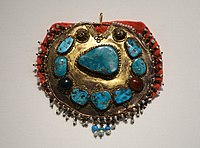South Arabia
South Arabia
جنوب الجزيرة العربية (Arabic) | |
|---|---|
 Map of South Arabia | |
| Country | |
| History of Yemen |
|---|
|
|
South Arabia (
.South Arabia is inhabited by people possessing distinctive linguistic and ethnic affinities, as well as traditions and culture, transcending recent political boundaries. There are two indigenous language groups: the now extinct
Etymology
The term Yamnat was mentioned in Old South Arabian inscriptions on the title of one of the kings of the second Himyarite Kingdom known as Shammar Yahrʽish II. The term was probably referring to the southwestern coastline of the Arabian peninsula and the southern coastline between Aden and Hadramout.[1][2][3] One etymology derives Yemen from ymnt, meaning "South", and significantly plays on the notion of the land to the right (𐩺𐩣𐩬).[4] Other sources claim that Yemen is related to yamn or yumn, meaning "felicity" or "blessed", as much of the country is fertile.[5][6] The Romans called it Arabia Felix (fertile Arabia), as opposed to Arabia Deserta (deserted Arabia). Classical Latin and
History

Three thousand years ago, several ancient states occupied the region of South Arabia, being
Geography
Ancient
Ancient kingdoms and appellations:
- Saba'
- Ma'īn
- Qatabān
- Ḥaḑramawt
- Awsān
- Himyar
- Arabia Felix (the term the Romans used to refer to South Arabia)
Pre-Islamic foreign occupiers:
- Axum (3rd–4th, 6th centuries)
- Sasanian Empire[16] (6th–7th centuries).
Islamic dynasties
- Umayyad661–750
- Abbasid750–897
- Ziyadid 819–1022
- Zaydi Imams 897-1962
- Najahid 1022-1158
- Sulaihid1047–1138
- Zurayid 1083-1193
- Mahdids 1159–1174
- Ayyubid1174–1228
- Rasulid1229–1454
- Tahiride1454–1526
Early modern and colonial

- Northern
- Yemen Eyalet, Ottoman Empire (1517–1635)
- Yemeni Zaidi State(1597–1849)
- Yemen Vilayet, Ottoman Empire (1849–, 1872–1918)
- Principality of Najran (1633–1934)
- Southern
- Aden city
- Aden Province (1839–1937)
- Colony of Aden(1937–1963)
- Regional
- Sultanate of Lahej (1728–1967)
- Aden Protectorate (1874–1959)
- Federation of Arab Emirates of the South(1959–1962)
- Federation of South Arabia (1962–1967)
- Protectorate of South Arabia (1963–1967)
- Aden city
Modern
Yemen:
- Unified
- Republic of Yemen(1990–present)
- Northern
- Idrisid Emirate (1906–1934)
- Sheikdom of Upper Asir (1916–1920)
- Mutawakkilite Kingdom of Yemen(1918–1962)
- Yemen Arab Republic (1962–1990)
- Southern
- Qu'aiti Sultanate (1858–1967)
- People's Republic of South Yemen(1967–1970)
- People's Democratic Republic of Yemen(1970–1990)
- Other articles
- Yemeni Unification(1990)
- North Yemen and South Yemen
- Democratic Republic of Yemen (1994)
- Greater Yemen
- South Yemen insurgency
- Houthi insurgency in Yemen(2015)
Beyond Yemen:
- 'Asir, Al-Bahah in Saudi Arabia
- Dhofar in Oman
See also
References
- ^ Jawād ʻAlī (1968) [Digitized 17 February 2007]. الـمـفـصـّل في تـاريـخ العـرب قبـل الإسـلام [Detailed history of Arabs before Islam] (in Arabic). Vol. 1. Dār al-ʻIlm li-l-Malāyīn. p. 171.
- ISBN 9789004176881.
- ISBN 1117531937.
He was worshiped by the Madhij and their allies at Jorash (Asir) in Northern Yemen
- ISBN 2-8017-0194-7.
- ISBN 9780810124172.
- ^ Edward Balfour (1873). Cyclopædia of India and of Eastern and Southern Asia, Commercial, Industrial and Scientific: Products of the Mineral, Vegetable and Animal Kingdoms, Useful Arts and Manufactures, Band 5. Printed at the Scottish & Adelphi presses. p. 240.
- ^ Origin Of Islam In Its Christian Environment Bell, Richard p.g 34
- ^ "Indian Ocean Trade Routes".
- ^ "William the Rebel: Musandam: The isolated land of the Shihuh". 19 December 2016.
- ^ Brian Doe, South Arabia (London: Thames & Hudson 1971) at 60–102.
- ^ Jean-Francois Breton, Arabia Felix (University of Notre Dame 1999) at 13–20, 23; 53–73; 3–5, 41–43.
- ^ al-Tabari, The History of al-Tabari, volume V, The Sasanids, the Byzantines, the Lakmids, and Yemen (S.U.N.Y. 1999), in Yemen: Ethiopian conquest at 179, 182–183, 204–208, 212; Persia over al-Habashah at 159–160, 236–249.
- ^ Stuart Munro-Hay, Aksum. An African civilization of late antiquity (Edinburgh Univ. 1991) at 71–74, 76–77 (3rd century), at 78–80 (4th century), at 84–88 (6th century).
- ^ Sally Ann Baynard, "Historical Setting" in The Yemens: Country Studies (Washington, D.C.: Foreign Area Studies, The American University, c.1985) 1–89, at 3–14: Ethiopians at 11–12 (4th century for 4 decades, 6th century for about 50 years); Persians at xiii, 12.
- ^ al-Tabari, The History of al-Tabari, volume VIII, The Victory of Islam (S.U.N.Y. 1997) at 114 (became Muslim).
- ^ Abū Muḥammad ʿAbd al-Malik b. Hishām, al-Sīra al-Nabawiyya. 3rd edition. 4 vols. (Beirut: Dār Ṣādir, 2010), 1:60-66; Fred M. Donner, Muhammad and The Believers: At the Origins of Islam (Cambridge: Belknap Press of Harvard University Press, 2012), 34; G.W. Bowersock, The Throne of Adulis: Red Sea Wars on the Eve of Islam (Oxford University Press, 2013), 117.






